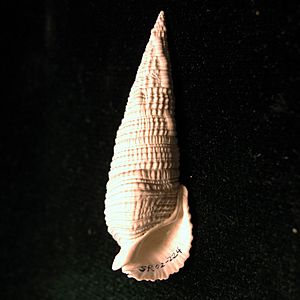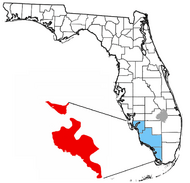Tamiami Formation facts for kids
Quick facts for kids Tamiami FormationStratigraphic range: Late Miocene-Late Pliocene ~13.06–2.6Ma |
|
|---|---|

Fossil (Cerithium dalli) from the Tamiami Formation
|
|
| Type | Geological formation |
| Sub-units | Buckingham Limestone Member, Ochopee Limestone Member, Bonita Springs Marl Member, Golden Gate Reef Member, Pinecrest Sand Member |
| Overlies | Hawthorn Group (see text) |
| Thickness | 50–100 ft (15–30 m) |
| Lithology | |
| Primary | Sandstone, claystone, limestone |
| Other | Phosphate |
| Location | |
| Region | Southwest Florida |
| Country | |
| Extent | Charlotte-Monroe Counties |
| Type section | |
| Named for | Tamiami Trail (highway) |
The Tamiami Formation is a special type of rock layer found in southwest Florida. It formed during the Late Miocene and Pliocene periods, which was millions of years ago. This formation is important because it tells us about Earth's history and the ancient life that lived there.
Contents
How Old Is This Rock Layer?
This rock layer is part of the Neogene period. It formed during the Late Miocene and Pliocene epochs. Scientists believe it is about 13.06 to 2.588 million years ago (mya). That's a very long time!
Where Can You Find It?
The Tamiami Formation is found in several counties in Florida. These include Charlotte, Lee, Hendry, Collier, and Monroe counties. It is spread out across a large part of Florida.
This rock layer is also part of an aquifer system. An aquifer is an underground layer of rock or sand that holds water. The Tamiami Formation sits on top of an older rock layer called the Hawthorn Group. In some places, a younger layer called the Caloosahatchee Marl sits on top of the Tamiami Formation.
What Is It Made Of?
The Tamiami Formation is made up of different kinds of rocks and materials. It has a mix of carbonate (like limestone) and siliciclastic (like sand and clay) materials. You can find it at or near the surface of the land in southern Florida.
Scientists have noticed that the top part of this formation is uneven. This means that it has been worn away by erosion over time.
Types of Rocks and Materials
The Tamiami Formation includes:
- Light gray to tan, loose, fine to coarse sand with fossils.
- Light gray to green, soft, sandy clay or clayey sand with fossils.
- Light gray, soft, very fine to medium sand that contains calcium carbonate and fossils.
- White to light gray, soft, sandy limestone with fossils.
- White to light gray, hard, sandy limestone with lots of fossils.
You can also find small amounts of Phosphate throughout the Tamiami Formation, mixed in with the sand and gravel.
Smaller Parts of the Formation
The Tamiami Formation is so big that scientists have divided it into smaller sections. These are called "members." Some of these members include:
- Bonita Springs Marl Member
- Golden Gate Reef Member
- Ochopee Limestone Member
- Pinecrest Sand Member
Ancient Life: Fossils!
The Tamiami Formation is famous for its many fossils! These fossils can be found as casts and molds, which are like imprints of ancient creatures. Sometimes, you can even find the original material of the animals.
Some of the fossils found here include:
- Barnacles
- Mollusks (like ancient clams and snails, such as Ostrea disparilis, Chione ulocyma, and Turritella pontoni)
- Corals
- Echinoids (like sea urchins and sand dollars)
- Foraminifers (tiny single-celled organisms)
- Nanoplankton (even tinier organisms, often made of calcium carbonate)
These fossils help scientists learn about the ancient environments and the types of plants and animals that lived in Florida millions of years ago.


